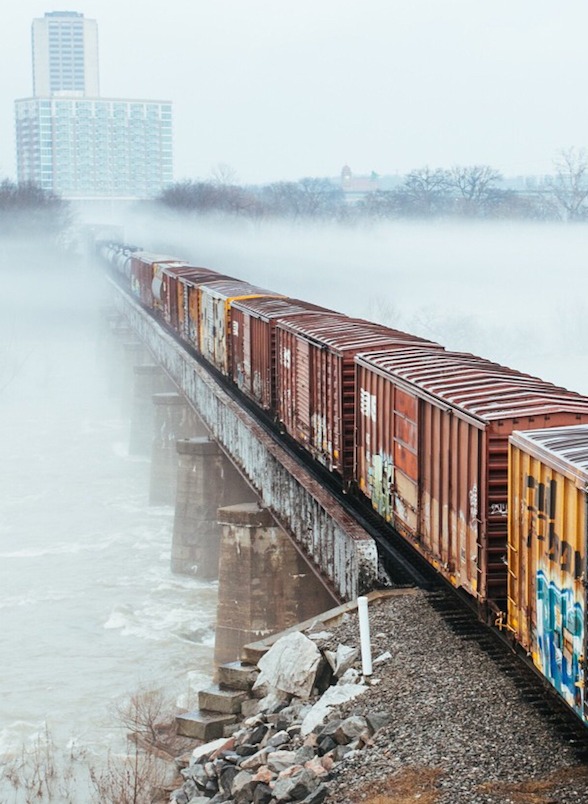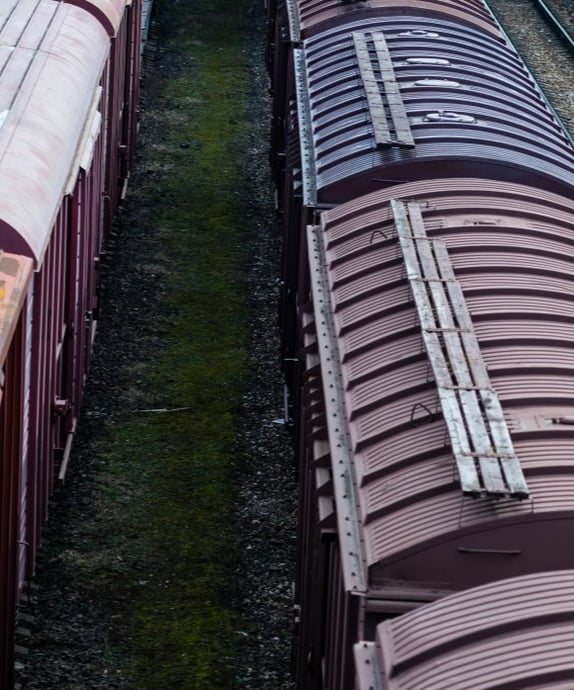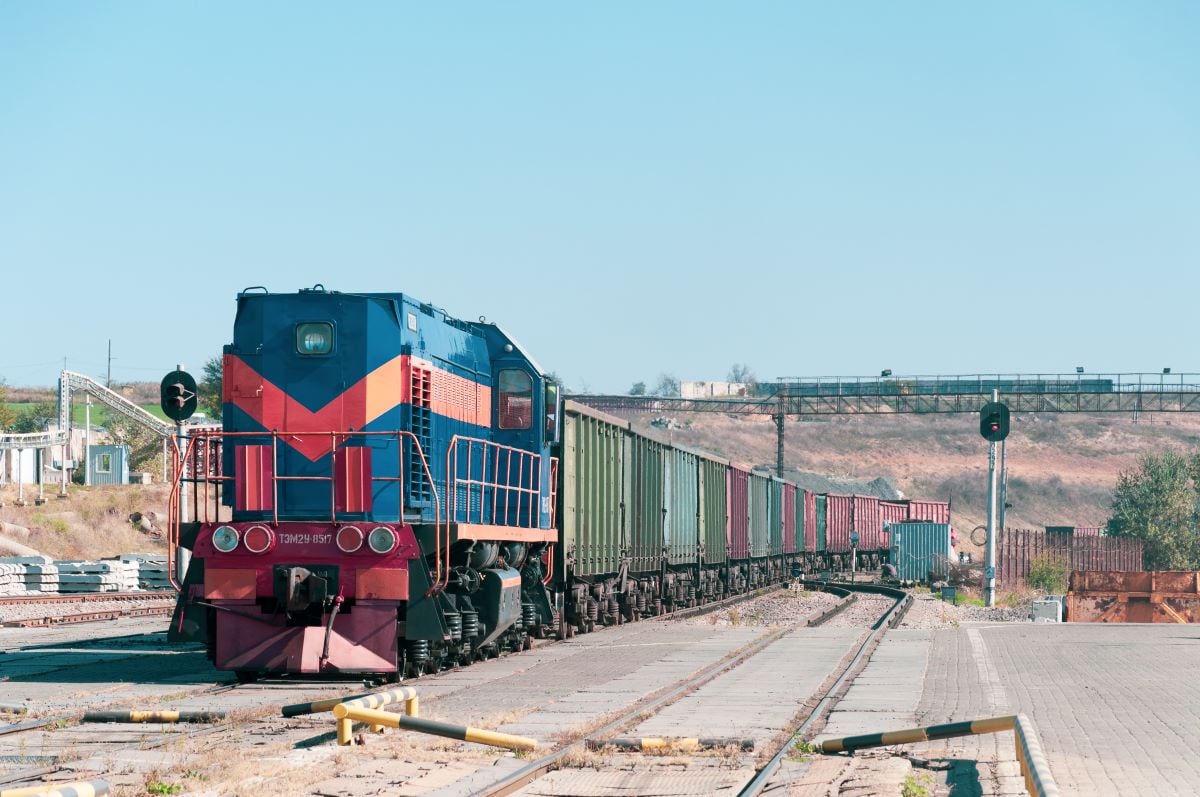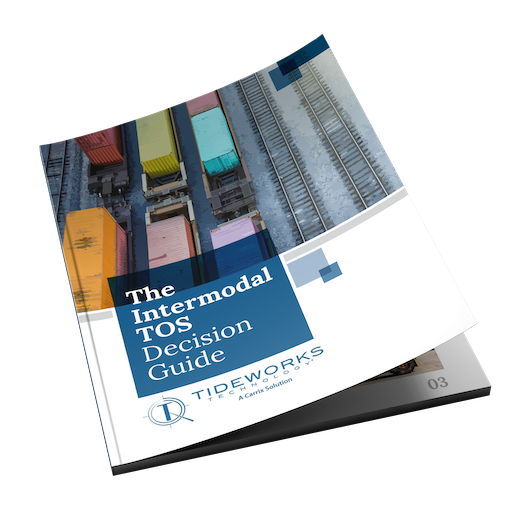State of the Industry Report: Intermodal Terminals
The domestic intermodal system is in a state of flux.
On one hand, demand is steadily growing. Terminals are increasing their capacity and investing in modernized equipment and software. Long-distance corridors are getting a boost to their carrying load with double and triple tracking upgrades. According to Precision Business Insights, the industry was estimated at $29.37 billion USD in 2022, with the expectation that the market will continue to grow at an estimated 13.8 CAGR through 2029.
On the other hand, 2023 has been marked by ups and downs. Larry Gross, president of Gross Transportation Consulting, told attendees at this year’s IANA Intermodal Expo that “Domestic freight bottomed out at the beginning of the year and has been kind of bumping along through May, and has actually started to trend upwards in a pretty seasonal manner and I’m hopeful we’ll continue to see that,” but added “With regard to the international side, we are still in a deep hole, down 15.7% year-over-year as of July. It’s not a terrific picture, but it’s not a bad picture.”
However, one thing is certain, intermodal operators are staring into an unpredictable future and should be making investments now to increase efficiency and capacity to help boost competitiveness in the future.
Speaking about the importance of improving market share vs. the trucking industry, Gross said, “We spend a lot of time thinking about the overall macro environment; actually, this is the biggest opportunity because we control our competitiveness against trucking and there is a giant opportunity to control our own destiny.”
Evan Armstrong, CEO of Armstrong & Associates, chimed in with measured optimism as well, “It’s very hard to compare this year to the last two, given what happened to us in 2021 and 2022. This year is a little more challenging,” said the CEO of Armstrong & Associates. “I think we’ll get into a more normal growth pattern in 2024 and then into 2025.”
How will rail get back to a normal growth pattern next year and beyond? By playing to its strengths. Rail offers several advantages, given that its fuel efficiency is four times greater than that of truck transportation. Intermodal transportation also offers increased cargo efficiency and never has to contend with highway traffic, so it’s typically much faster and more precise, thanks to GPS tracking.
More companies are calculating new ways to reduce both their freight costs and carbon footprint. These alternative transportation options should be prioritized when moving freight over long distances.
Although trucking continues to dominate the domestic shipping market, intermodal freight transport offers many improvements, including reduced emissions and freight savings. These improvements only become more apparent when looking at 500 miles or more journeys. Intermodal transport is more secure and can also help reduce costs associated with cargo handling, loss, and damages.
Overall, the intermodal industry’s future looks bright, but it has several challenges that stand in the way before it can realize its potential.
Challenges Faced By Intermodal Terminal Operators
Competition has always been a friction point for terminal operators. Intermodal shipping is defined as transport using two or more modes of transportation. Still, both rail and truck companies prefer to complete long-distance moves alone whenever they can, defeating possible efficiencies in the system.
There are also frequent disagreements over how the industry’s shared trust funds should disperse their investments. Those paying into the funds expect returns to benefit them specifically and aren’t concerned with projects that benefit the system overall.
These large projects are challenging to orchestrate because the benefits are frequently uneven, which doesn’t sit well with those who feel they’re paying more than their fair share.
Beyond the general difficulties intermodal operators face, there are further evolving challenges in global supply chain disruptions, chassis shortages, volume volatility, operational inefficiencies, and automation.
These large projects are challenging to orchestrate because the benefits are frequently uneven, which doesn’t sit well with those who feel they’re paying more than their fair share.
Beyond the general difficulties faced by intermodal operators, there are further evolving challenges in global supply chain disruptions, chassis shortages, volume volatility, operational inefficiencies, and automation.
1. Global Supply Chain Disruptions
Before COVID-19, the US was heading towards a recession in the later months of 2019. This put pressure on terminal operators who were facing lowered rates but no commensurate decline in costs.
As a result, there was a 7.4% decline in total North American intermodal volumes in the fourth quarter compared to the same quarter in 2018. During the same period, there was a 2.7% drop in domestic containers, a 9.1% decline in international shipments, and a 21.4% reduction in trailers. Losses continued into January 2020, in time to meet a challenge no one could have predicted – COVID-19.
Congestion Cleanup Continues
The beginning of COVID-19 quickly rippled through the supply chain, starting in China, the world’s largest manufacturing hub. Travel restrictions led to driver shortages, backlogging cargo at China’s major container ports, and canceling ocean carrier sailings.
The pandemic quickly spread around the world, leading to a variety of public safety measures, including lockdowns, border closures, and social distancing — all of which affected the speed and movement of goods.
Fast forward to 2022, many countries made great strides to reduce necessary public safety measures, but there were still many places in the world affected by COVID-19.
In March 2022, strict COVID-19 testing protocols imposed in Shanghai jammed up air freight warehouses at Shanghai Pudong Airport as well as container vessels sitting at the Shanghai-Ningbo port. As a result, trucking costs in Shenzhen increased by more than 300% due to a backlog in orders and a severe driver shortage following the introduction of new local COVID restrictions.
Intermodal’s share of freight has continued its steady decline since 2016, when it enjoyed a 6.7% domestic market share. By Q2 2023, this figure fell to 5.5%, resulting in an annual revenue loss of $4 billion for the industry.
Recovery will continue on the back of reliability, resilience, and customer service, say industry experts.
In September, at the IANA Intermodal EXPO, Norfolk Southern Intermodal Group Vice President Andrew Lynch said, “If we want to give our customers an avenue to grow, our service needs to be reliable, it needs to be resilient and it needs to be done over a long enough time that we get out of the pendulum swing of win freight, lose freight, win freight back and lose it again. We make service, we sell service, that’s the only product that we make.”
Recovering from Overcorrection
In October 2021, consumer spending on durable goods was 40% higher than it had been just two years earlier.
Michael Zezas, the Head of Public Policy Research and Municipal Strategy for Morgan Stanley, put it in simpler terms at the time: “The most important trigger of supply chain disruptions, in our view, has been a surge in demand for physical goods as a result of record stimulus programs and a sharp shift in spending from services to consumer durables," he says. “As demand normalizes… so too should the production and movement of physical goods.”
However, the industry’s response to this sudden demand increase may have been heavy-handed.
Alan Murphy, CEO of Sea-Intelligence, said the shipping lines were massively overbuilt during the pandemic and now the industry has too many ships in a down market. “Globally, basically, we’re back to 2019. What does that tell you? That massive volume boom during the pandemic was wiped away,” he said. “That boom is gone. It’s back to zero. The pandemic volume came and went, and we’re back to where we were four years ago.”
He later added, “I’m very pessimistic for not just the short term, but medium term when it comes to container shipping. It’s hard to feel sorry for the shipping lines because all of these wounds are self-inflicted, and everyone said, ‘don’t order more vessels,’ and there was a massive shortage of vessels during the pandemic.”
Labor Shortages and Worker Turnover
The forever labor shortage may be upon us.
The impact of the resulting worker retention challenges and rising labor costs have made themselves felt throughout the value chain. These challenges have pushed private sector wages to increase more than twice the long-term pre-COVID-19 growth rates, yet positions still remain unfilled.
There are several underlying factors that are contributing to this imbalance, including:
Evolving work preferences
Demand shifts from services to goods
Accelerated retirements
The shift toward e-commerce (resulting in spikes in demand for workers in the American warehousing and parcel sectors)
“We have to get a little bit more aggressive with wages, and we’ve also done some creative things with referral bonuses,” says Kent Musick, president of Bridgman, Michigan-based chassis manufacturer Pratt Industries. “As a strategic move, we moved to weekly payroll instead of biweekly to entice more people to come on board with us. We’re looking at every avenue we can to be the employer of choice in our area.”
2. Chassis Shortage
In addition to supply chain disruptions, there also is a critical shortage of the chassis used to transport containers. Several contributing factors include:
Increased Dwell Time for Existing Chassis
Since importers are taking longer to unload containers, resulting in slower returns of empty boxes, chassis are circulating slower than usual. Some intermodal rail terminals will also not accept empty containers, leaving the chassis under the empty containers stuck in limbo. Even as containers move away from ports, inter-yard labor and equipment shortages are causing further delays.
Supply Chain Disruptions Hurt Chassis Production
Companies at every level of the transportation industry are eager to fill in the chassis shortage with as many chassis as they can get their hands on. However, many of the same issues affecting the supply chain are also affecting the production of shipping container chassis.
Despite this, manufacturers are working diligently to make chassis as quickly as possible but are still struggling with everything from hiring laborers to procuring the right components. Market research initially thought supply issues would improve by Q3 2022, but the problem continues to persist.
Aging Chassis Fleet
As demand soars, an aging chassis fleet in the United States is also rapidly breaking down. The average age of an intermodal chassis is at least 15 to 20 years old, with many even older. This average fleet age has led to problems like:
- Breakdowns
- Blown-out tires
- Outdated features
- Lack of availability
Combine the aging fleet with the levels of demand we’re currently experiencing, and it’s no wonder the industry is suffering from a critical lack of capacity to move goods through the global supply chain.
3. Volume Volatility
Volume volatility is a considerable challenge for intermodal terminals today. These vast swings in demand make it difficult for terminals to operate efficiently. It’s easy to see this reality by examining the following recent statistics.
- Intermodal volumes for Q1 2023 were down approximately 8%.
- Total combined U.S. traffic (carload plus intermodal traffic) for the first half of 2023 fell 5.5% compared to 2022.
- Even East Coast ports, which are traditionally less busy, handled a record high container volume in March 2021.
- Some industries, notably Motor Vehicles and Parts, saw a tremendous surge in rail usage, increasing approximately 12% YoY between June 2022 and June 2023.
Volume volatility makes planning labor and yard allocations exceedingly difficult, particularly when incoming containers need a chassis and a parking space. Because incoming and outgoing freight compete for the same resources, efficiency drops off dramatically when capacity is stretched too thin.
Additionally, fluctuations in volume can increase congestion at the gate, causing truck turn times and dwell time to rise. Congestion can also lead to bottlenecks in the yard and added delays.
There are nearly limitless factors that can lift demand or push demand down monthly, weekly, or daily. When something disrupts the normal flow of goods, freight volumes can dip and climb violently.
Some terminals have had to lease or buy additional land and develop it for yard storage in response to surging demand. This is expensive and isn’t typically possible for most terminals, especially those located in urban areas.
4. Operational Inefficiencies
Many operational inefficiencies can hold up an intermodal yard, causing backlogs that only perpetuate supply chain delays. Some of the most common include:
- Slow Gate Processing Times: Most terminals need their trucks to enter and exit their gates at specific intervals. If terminals don’t have a reliable method for measuring their gate times, it delays this process. Fortunately, many terminals are taking advantage of software that optimizes gate processes, helping with everything from sequencing incoming trucks to time slot management and scheduling.
- Optimizing Over-the-Road Truckers: Previously, many working in the transportation industry assumed that terminals were better at organizing cargo while trucks simply got in the way. Now, new software tools are contributing to a shift in this mentality.
- Maximizing Yard Space Utilization: Effective yard utilization is a critical component of any long-term efficiency plan. If a terminal yard is not well-organized, more terminal convenience moves have to be made, which leads to longer turn times.
5. Automation
Most terminal operators recognize that some level of automation is necessary to remain competitive in a rapidly shifting industry. However, historically, intermodal terminal operators have been resistant to change. That has made it difficult for automation to gain the foothold it needs to create systemic change in the world’s intermodal supply chain.
As the intermodal industry takes baby steps in automating container transfer facilities, it will be important to remember that managing expectations and gaining user adoption will be the biggest challenge.
This process of automating an intermodal facility, which is still in the very early stages, should be slow and deliberate to ensure the best results. These automation projects also require larger budgets, sometimes reaching into the hundreds of millions.
While the move to automation may cause concern and fear among customers, operators can reassure all stakeholders by installing the best possible terminal operating system (TOS) to link equipment, tracking mechanisms, and machines into one platform that can provide instant communication and real-time updates. These systems integrate with automated equipment, giving operators holistic control over their entire operation within one united interface.
These automated systems also generate a massive amount of data, which can be immensely useful to individual operators and the industry as a whole. In the past, a lack of data standards has hamstrung efforts to modernize aspects of the intermodal operating system.
Despite these potential advantages, selecting the right provider is difficult for operators, given the complexity of offerings and the associated costs. There is a lot to consider before updating your terminal operating system.

Want to learn a bit more before you make your decision?

What Does the Future of Intermodal Terminal Operations Look Like?
Despite the myriad of challenges faced by the industry, most insiders are bullish about future prospects. Intermodal transport is tightly integrated into the fabric of commerce and industry and will find its way to solutions. Technology will be the most vital driver of this evolution.
It’s important to note that terminals of all types and sizes face similar changes, but have unique operational needs.
- Conventional terminals (legacy terminals that have been operating for decades profitably) rely on heaps and are starting to require more container visibility as supply chain disruptions have created volume challenges and physical constraints. They also use RTG cranes that require a different mix of solutions than a highly automated wide-span crane terminal.
- Hybrid terminals require even more flexible software systems to handle varying types of traffic, avoid congestion, and mitigate chassis shortages.
The intermodal landscape is constantly shifting as new technologies and global dynamics drive creative disruption and create new ways of doing business.
Transportation Management Systems
A transportation management system (TMS) helps the entire intermodal system run more efficiently. This technology allows for total transparency of shipped goods across the supply chain, from factories, through intermodal transport, to eventual warehouse destinations.
TMS technology has existed for decades, but modern, cloud-based systems allow much finer granularity and vastly improved data analysis features. Users gain real-time insights, improved communication, routing guide automation, and management by exception functionality.
The inclusion of artificial intelligence further expands the capabilities of the technology, removing some of the guesswork that was previously unavoidable. A modern TMS can automatically adjust shipping schedules, reroute cargo due to known or anticipated delays, and alter pickups and drop-offs for true adaptability.
Container Tracking and Barcode Technology
Terminal operators are utilizing advanced implementations of barcode and RFID chip technology to make tracing, sorting, and delivering more reliable.
Using automated cameras and handheld scanners, terminal workers can quickly access detailed information and update critical tracking data. They’re given immediate access to sophisticated supply chain information using Tracking Trace technology.
Barcodes and RFID chips are critical foundational technologies on top of which many others are built. Transportation management systems use them, as do terminal operating systems, which we’ll discuss next.
Unfortunately, most of the equipment tracking solutions available today are both resource-prohibitive and labor-intensive to install. Generally, operators reserve them for larger pieces of machinery, such as side-picks, RTGs, or top-picks. Since there are fewer pieces of larger equipment in most operations, the installation gets a bit easier.
However, what about the many UTRs that spend endless shifts cycling cargo back and forth between larger pieces of equipment? Most medium to large terminal operations run too many UTRs to make most tracking solutions practical.
Fortunately, Tideworks TANGO Trace and Go makes it easier to track UTRs, regardless of whether you have 30 or 300, using simple, off-the-shelf GPS technology. Available in Terminal View, this cutting-edge innovation offers operators the opportunity to see the inner workings of their yard and avoid even the most elusive bottlenecks.
Comprehensive Terminal Operating Systems (TOS)
The best TOS solutions designed for intermodal terminals are capable of uniting a singular view of all personnel, processes, and equipment into one technical solution. This gives the operator unprecedented control over every movement in their terminal yard.
Additionally, the inclusion of AI and automation capabilities allows the system to offer insights that once would have taken operators hours or even days to achieve. This includes everything from planning the most optimal moves to analyzing real-time data for deep insights into processes that can save both time and money.
Tideworks’ Intermodal PRO TOS has been used by intermodal terminals all over the world and is prized by operators primarily because of its capabilities, as well as its adaptability. The interface is easy to use and intuitive to learn, with simple drag and drop functionality to help speed up ramping and deramping orders.
With extensive reporting capabilities, advanced integrations, real-time yard planning, and more, IPRO enhances a terminal’s productivity and empowers them to make data-backed decisions with full confidence.
Environmentally Friendly Solutions
To help protect our environment as well as future business growth, terminal operators and transport businesses must adopt greener solutions as soon as they become available. One gaining traction is Short Sea solutions with Full Container Load (FCL) and Less than Container Load (LCL) options, due to their ability to help reduce costs and increase environmental benefits.
Other options include Greencarrier’s Freight Services, which uses fully electric freight trains to transport goods between China and Europe. These hydroelectric trains drastically cut emissions when compared to the traditional option.
Another great example is the hybrid solar car built by Kawasaki Kisen Kaisha. Made with 900 integrated solar panels, it generates enough electricity to power all the surface lights required for its own operation.
Even within your terminal, every equipment move has an environmental impact. The fewer moves you have to do, the lower your terminal’s environmental impact.
Addressing your terminal’s carbon footprint doesn’t just help our planet – it can be a significant selling point for customers as well. Using less fuel for inter-terminal moves also saves money through lower fuel costs and decreased wear and tear on equipment.
Through its advanced AI insights and easy-to-use terminal interface, Tideworks’ TANGO Trace and Go can help you lower your terminal’s environmental impact, providing benefits for your company, your customers, and our planet.
Automation and Business Intelligence
Over the last several years, we’ve seen firsthand how technological innovations are driving forward the future of our industry. Driven by advancements like automation, AI, and big data analysis, businesses are now pushing the boundary of what was previously thought possible. This leads to shifts in traditional intermodal terminal practices, affecting everything from hiring to strategic terminal planning.
The Tideworks Traffic Control system offers unparalleled control over container handling equipment and helps take the guesswork out of planning efficient moves. This system can also:
- Generate and dispatch work instructions to operators
- Help to increase equipment utilization
- Organize scheduling to boost productivity
When paired with Traffic Control, the 3D data visualization platform Terminal View helps to give operators a visual representation of moment-to-moment activity around their terminal. They can instantly locate any piece of equipment, container, or handling equipment, uncover potential bottlenecks, and even track hazardous material.
The third factor in this system is Tideworks Insight, a real-time data platform that offers:
- Increased visibility into both operational and business data
- Data analytics capabilities
- Custom metrics and reports
This allows operators to track their operations in detail to discover efficiencies and evaluate trends for future strategic planning.
How Is Tideworks Taking Intermodal Rail Terminals Into the Future?
Regardless of the size of your terminal, Tideworks Technology can grow with you, helping to take your intermodal rail terminal into the future.
Our technology solutions offer everything from a clear view of your terminal to the meaningful data insights you need to make more intelligent and informed decisions about everything from terminal convenience moves to staffing.
Our extensible system has been meeting the needs of terminals worldwide, assisting as operators strive to make their intermodal terminals and yards more environmentally friendly and easier to manage.
We explicitly designed IPRO for intermodal terminals and their specific needs as operations continue to grow. Now, IPRO is rewriting what’s possible for intermodal terminal operations, bringing every critical function under your control.
To learn how Tideworks can help your terminal meet the needs of tomorrow, contact us today.


